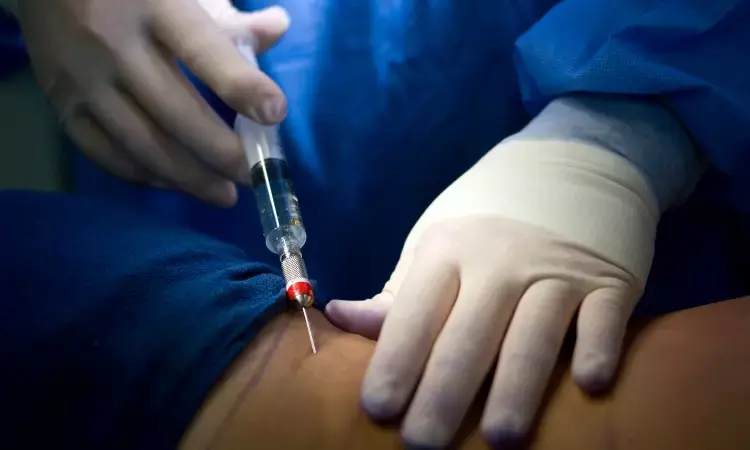- Home
- Medical news & Guidelines
- Anesthesiology
- Cardiology and CTVS
- Critical Care
- Dentistry
- Dermatology
- Diabetes and Endocrinology
- ENT
- Gastroenterology
- Medicine
- Nephrology
- Neurology
- Obstretics-Gynaecology
- Oncology
- Ophthalmology
- Orthopaedics
- Pediatrics-Neonatology
- Psychiatry
- Pulmonology
- Radiology
- Surgery
- Urology
- Laboratory Medicine
- Diet
- Nursing
- Paramedical
- Physiotherapy
- Health news
- Fact Check
- Bone Health Fact Check
- Brain Health Fact Check
- Cancer Related Fact Check
- Child Care Fact Check
- Dental and oral health fact check
- Diabetes and metabolic health fact check
- Diet and Nutrition Fact Check
- Eye and ENT Care Fact Check
- Fitness fact check
- Gut health fact check
- Heart health fact check
- Kidney health fact check
- Medical education fact check
- Men's health fact check
- Respiratory fact check
- Skin and hair care fact check
- Vaccine and Immunization fact check
- Women's health fact check
- AYUSH
- State News
- Andaman and Nicobar Islands
- Andhra Pradesh
- Arunachal Pradesh
- Assam
- Bihar
- Chandigarh
- Chattisgarh
- Dadra and Nagar Haveli
- Daman and Diu
- Delhi
- Goa
- Gujarat
- Haryana
- Himachal Pradesh
- Jammu & Kashmir
- Jharkhand
- Karnataka
- Kerala
- Ladakh
- Lakshadweep
- Madhya Pradesh
- Maharashtra
- Manipur
- Meghalaya
- Mizoram
- Nagaland
- Odisha
- Puducherry
- Punjab
- Rajasthan
- Sikkim
- Tamil Nadu
- Telangana
- Tripura
- Uttar Pradesh
- Uttrakhand
- West Bengal
- Medical Education
- Industry
AI improves capturing and interpretation of ultrasound images: Study

UK: A new study conducted by James S. Bowness and colleagues suggests that the capture and interpretation of ultrasound images improved when an assistive artificial intelligence (AI) device was used. The findings of this study were published in the British Journal of Anaesthesia.
The use of ultrasound to see important landmarks, targets, and safety structures is a prerequisite for ultrasound-guided regional anesthesia. However, this may be difficult, especially for practitioners who are just starting out. Ultrasound image interpretation is increasingly being done with the help of artificial intelligence. In this exploratory investigation, researchers assessed non-experts' abilities to do ultrasound scanning during ultrasound-guided regional anesthesia both with and without the use of an AI system.
For this study, the ultrasound scanning for six peripheral nerve blocks was taught to twenty-one anesthesiologists who were all novices in ultrasound-guided regional anesthesia. Each person then carried out a scan for each block, performing half of them with and a half without AI support. The proper acquisition of each block view and the accurate identification of sono-anatomical features on each image were evaluated by experts. Scan confidence was reported by participants, experts supplied a global assessment score for the effectiveness of the scan, and scans were timed.
The key findings of this study were:
1. 126 ultrasound scans were evaluated by experts.
2. When using the device, participants correctly identified the block view in 56/62 (90.3%) scans as opposed to 47/62 (75.1%) scans (two data points missing).
3. In comparison to 161/208 (77.4%) without the device, 188/212 (88.8%) correctly identified sono-anatomical features on the view. Participant confidence, expert global performance score, or scan duration did not differ significantly overall.
It was shown that using ScanNav Anatomy Peripheral Nerve Block led to better ultrasound picture capture and analysis. The authors drew a conclusion that such technology may be employed in the future to improve non-experts' performance and perhaps increase patient access to these procedures.
Reference:
Bowness, J. S., Macfarlane, A. J. R., Burckett-St Laurent, D., Harris, C., Margetts, S., Morecroft, M., Phillips, D., Rees, T., Sleep, N., Vasalauskaite, A., West, S., Noble, J. A., & Higham, H. (2022). Evaluation of the impact of assistive artificial intelligence on ultrasound scanning for regional anaesthesia. In British Journal of Anaesthesia. Elsevier BV. https://doi.org/10.1016/j.bja.2022.07.049
Neuroscience Masters graduate
Jacinthlyn Sylvia, a Neuroscience Master's graduate from Chennai has worked extensively in deciphering the neurobiology of cognition and motor control in aging. She also has spread-out exposure to Neurosurgery from her Bachelor’s. She is currently involved in active Neuro-Oncology research. She is an upcoming neuroscientist with a fiery passion for writing. Her news cover at Medical Dialogues feature recent discoveries and updates from the healthcare and biomedical research fields. She can be reached at editorial@medicaldialogues.in
Dr Kamal Kant Kohli-MBBS, DTCD- a chest specialist with more than 30 years of practice and a flair for writing clinical articles, Dr Kamal Kant Kohli joined Medical Dialogues as a Chief Editor of Medical News. Besides writing articles, as an editor, he proofreads and verifies all the medical content published on Medical Dialogues including those coming from journals, studies,medical conferences,guidelines etc. Email: drkohli@medicaldialogues.in. Contact no. 011-43720751


